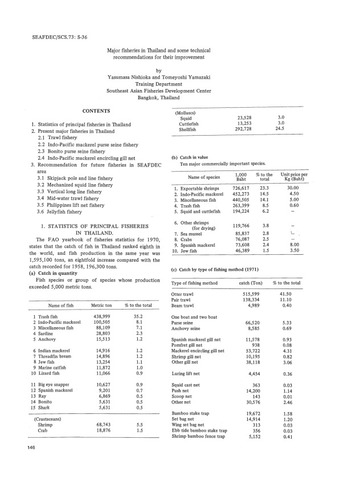| dc.contributor.author | Rumpet, Richard | |
| dc.contributor.author | Awang, Daud | |
| dc.contributor.author | Musel, Jamil | |
| dc.contributor.author | Biusing, Rooney | |
| dc.date.accessioned | 2019-01-17T04:23:41Z | |
| dc.date.available | 2019-01-17T04:23:41Z | |
| dc.date.issued | 1999 | |
| dc.identifier.citation | Rumpet, R., Awang, D., Musel, J., & Biusing, R. (1999). Distribution, abundance and biological studies of economically important fishes in the South China Sea, Area II: Sarawak, Sabah and Brunei Darussalam waters. In Proceedings of the Second Technical Seminar on Marine Fishery Resources Survey in the South China Sea, Area II: West Coast of Sabah, Sarawak and Brunei Darussalam, 14-15 December 1998, Kuala Lumpur, Malaysia (pp. 353-361). Samut Prakan, Thailand: Training Department, Southeast Asian Fisheries Development Center. | en |
| dc.identifier.uri | http://hdl.handle.net/20.500.12067/827 | |
| dc.description.abstract | The studies were carried out between 9th July and 3rd August 1996 (3rd cruise) and 30th April and 30th May, 1997 (4th cruise) in the Exclusive Economic Zone of Sarawak and the western part of Sabah. The species distribution, abundance, composition and length-weight relationships of some commercially important fish were investigated and compared for both cruises. The results indicates that the overall catch rate ranged from 3.5 to 194 kg/hr and averaged at 55.9 kg/hr during the 3rd cruise. For the 4th cruise, it ranged from 10.9 to 90.5 kg/hr and averaged at 50.2 kg/hr. During the 3rd cruise, 46.9% of the catch were dominated by demersal fish followed by 41.6% trash fish, 7.8% pelagic fish and 3.1% cephalopod. Priacanthidae was the most dominant family, which made up of 14.1% of the catch followed by Nemipteridae (10.8%), Carangidae (5.0%), Lutjanidae (3.7%) and Mullidae (2.1%). The ten most dominant species found during the 3rd cruise were 1. Priacanthus macracanthus (13.2%), 2. Nemipterus bathybius (3.3%), 3. Abalistes stellaris (2.8%), 4. Arius spp.(2.5%), 5. N. nematophorus (2.2%), 6. Gymnocranius griseus (1.9%), 7. N. marginatus (1.7%), 8. Sepia spp. (1.7%), 9. Decapterus spp. (1.6%) and 10. Carcharhinus spp (1.3%). During the 4th cruise, the family Nemipteridae (12.7%) formed the most dominant fish family followed by Carangidae (8.7%), Mullidae (7.1%), Lutjanidae (4.9%) and Priacanthidae (2.2%). The ten most dominant species were: 1. Loligo spp. (5.7%), 2. Nemipterus bathybius (4.2%), 3. Abalistes stellaris (4.0%), 4. Upeneus moluccensi (3.8%), 5. Nemipterus nemurus (3.8%), 6. Gymnocranius griseus (3.2%), 7. Carangoides malabaricus (3.2%), 8. Plectorhynchus pictus (3.1%), 9. Upeneus bensasi (2.4%) and 10. Arius spp. (1.8%). The morphometric study shows that the population of fish are normally distributed. | en |
| dc.language.iso | en | en |
| dc.publisher | Training Department, Southeast Asian Fisheries Development Center | en |
| dc.subject | South China Sea | en |
| dc.subject | Malaysia | en |
| dc.subject | Sarawak | en |
| dc.subject | Sabah | en |
| dc.subject | Brunei Darussalam | en |
| dc.title | Distribution, Abundance and Biological Studies of Economically Important Fishes in the South China Sea, Area II: Sarawak, Sabah and Brunei Darussalam Waters | en |
| dc.type | Conference paper | en |
| dc.citation.spage | 353 | |
| dc.citation.epage | 361 | |
| dc.subject.asfa | marine fish | en |
| dc.subject.asfa | fishery surveys | en |
| dc.subject.asfa | pelagic fisheries | en |
| dc.subject.asfa | demersal fisheries | en |
| dc.subject.asfa | commercial species | en |
| dc.subject.asfa | fishery biology | en |
| dc.citation.conferenceTitle | Proceedings of the Second Technical Seminar on Marine Fishery Resources Survey in the South China Sea, Area II: West Coast of Sabah, Sarawak and Brunei Darussalam, 14-15 December 1998, Kuala Lumpur, Malaysia | en |



